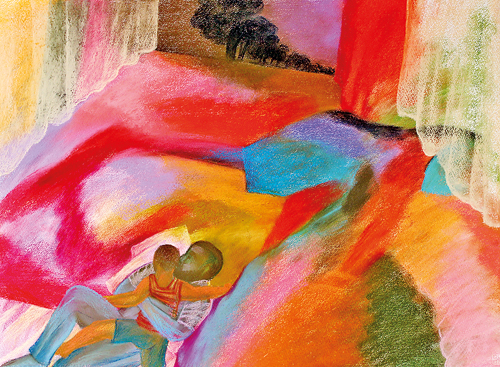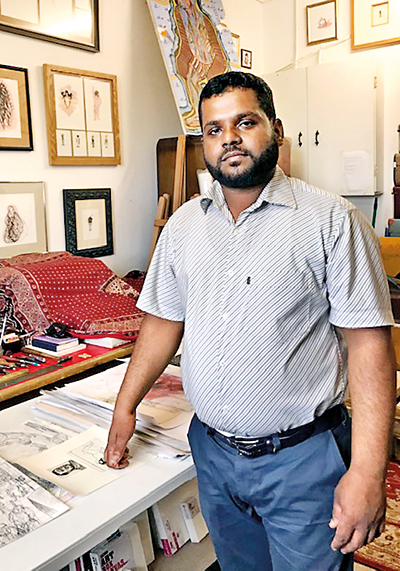From exhibition at Matale Town Hall to Royal Collection
His north London studio, situated in a quiet industrial unit, contains an eclectic mix of paintings, leather-bound books, drawing utensils and art material. Paintings of various sizes –some complete, others works in progress, fill the white walls of the small space.

‘The Cuddle’ and right: Arjuna Gunarathne, at his north London studio
Seated, perhaps where he often sits to survey his work, on a sturdy yet battered chair, is Arjuna Gunarathne, a young Sri Lankan artist based in London.
One of the recent works of this talented, unassuming man of few words has been selected for the Royal Collection – the art collection of the British royal family – which comprises paintings of Great Masters such as Michaelangelo and Leonardo Da Vinci.
Studying for his Master’s at the Royal Drawing School, founded in 2000 by the Prince of Wales, Gunarathne’s most recent works (including the painting selected for the Royal Collection) were exhibited for sale at London’s prestigious auction house, Christie’s, for six days from November 9-14.
Gunarathne was one of five featured artists at the exhibition titled, ‘The Drawing Year 2017–18 Postgraduate Programme End of Year Exhibition’ organised by the Royal Drawing School. Each student on the Postgraduate Programme will have a work chosen from their end of year exhibition to become part of the Royal Collection.
 “This is a huge opportunity for me,” beams the artist, whose journey had begun with a solo exhibition in 1995 at the Matale Town Hall.
“This is a huge opportunity for me,” beams the artist, whose journey had begun with a solo exhibition in 1995 at the Matale Town Hall.
Gunarathne whose forte is miniature art, last exhibited in Sri Lanka (Me, Myself and I) at the Barefoot Gallery in Colombo (2010). His other works have been exhibited in Colombo between 2000 and 2010.
However, nothing beats the experience of having a work selected to the Royal Collection.
“This is a really exciting time for me. I couldn’t believe it when I received the news from the school (the Royal Drawing School). I had the honour of meeting renowned artists and many art enthusiasts at the opening of the Christie’s exhibition,” shared Gunarathne, whose exhibitions have been around the world, including at the Gallery Rohtas 2, Lahore, Pakistan (2004),Museum fur Volkerkunde Wien in Vienna, Austria (2008) and Dhaka Art Summit,Bangladesh (2018).
“I am truly honoured to have contributed to the Royal Collection. I can’t say I was this excited when three of my works (Books, T-Shirts I and T-Shirts II) were exhibited at the Museum fur Volkerkunde Wien and at other European locations in 2008,” said Gunarathne, a former recipient of the Madanjeet Singh Art Scholarship for SAARC students, who has completed a course in miniature painting at the School of Visual Art, Beaconhouse National University, Pakistan.
“That time I spent in Lahore was very special. I travelled to remote corners of the country, sometimes on foot; mixed with the people; ate local food and most importantly, took in the visual treats the country had to offer in terms of ancient paintings, architecture and cultural diversity,” said Gunarathne with a tinge of nostalgia.
Little had he known that his later works would be influenced by the textile industry of Pakistan and the miniature art form that he mastered in Lahore. Among Gunarathne’s exhibits are miniature paintings inspired by the Moghul era.
“Miniature painting is a precise craft,” explains Gunarathne, who must first prepare the paper for his miniature paintings before he can start painting.
“Once the paper is glued, it must dry before I can start work on my paintings. Luckily, we had a hot summer this year and I managed to make the most of it,” continues Gunarathne as a stream of sunlight pours in to the studio on this crisp autumn afternoon.
The space smells of fresh paint and varnish. Gunarathne explains the technique of miniature paintings, sharing examples of his work. He is unhurried.
The detailing on the paintings is fine and sophisticated.
He then focuses on his larger works. They are based on his personal and social experiences as a migrant (his family’s process of adaptation to their ‘adopted’ country) and are shaped by his personal interactions with fellow migrants.
“When I first came to England, people wanted to know where I came from. My origin mattered because of my skin colour,” says Gunarathe, whose primary focus today is on themes such as colour, identity and otherness.
“I put myself on my paintings. A brown man. There are conflicts, uncertainties and struggles, when you relocate. But the first thing people notice is your skin colour.
“I am not making a political comment. London is a multicultural city and people are largely accepted for who they are. But I want people to understand that the migrant experience can be full of conflict and existential dilemmas,” Gunarathne gives context and confides that it is his young son’s experiences as a child of Sri Lankan descent, born in London to migrant parents, which prompted his current works concerned with migration and migrants’ struggles vis-à-vis self and family life.
“I think it is helpful to look at the experience from a personal, or family point of view. That is what I am doing through these paintings.”
Gunarathne’s paintings, which include works titled ‘Cuddle,’ a response to his son’s questioning of the family’s skin colour in a predominantly ‘white’ country; ‘Airborne’ capturing the sense of disorientation felt by migrants who uproot themselves from home countries and ‘Bubble I & II’ questioning where a migrant belongs, are being exhibited at the Royal Drawing School Shoreditch, London, from November 28 to January 16, 2019.
“Arjuna has been able to deftly fuse his interest and proficiency in ancient mural paintings, with new found skills acquired on the Drawing Year, resulting in highly personal and emotive drawings. His work has an intimacy and softness, displayed best in his sensitive drawings of family and pushed further in his imaginative large scale pastel works” says Fraser Scarfe, Drawing Year Manager at the Royal Drawing School.


